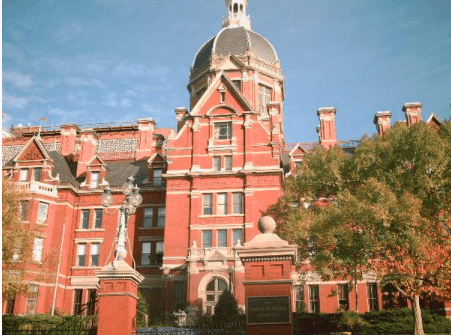Philip R. Liebson
Chicago, Illinois, United States
 |
| Johns Hopkins, where Dandy studied. Photo by Lizardraley99, 2012. Via Wikimedia. CC BY-SA 3.0 |
Three pioneers established the discipline of neurosurgery. They were the British surgeon Victor Horsley and the Americans Harvey Cushing and Walter Dandy. Both Americans were surgeons at Johns Hopkins Hospital and Dandy (1886-1946) was the youngest. His innovations include the first clipping of an intracranial aneurysm, the surgical management of hydrocephalus, and many other procedures such as pneumoencephalography and brain endoscopy.
Dandy grew up in Sedalia, Missouri, and studied at the state university and at Johns Hopkins School of Medicine. In 1910 Johns Hopkins, Harvard, and Columbia had the best graduate programs of America. Johns Hopkins, however, also had the four outstanding leaders in medicine, painted in London in 1905 by John Singer Sargent.
Johns Hopkins Hospital had opened in 1889 and the medical school in 1893. Its medical school curriculum consisted of a full four years program instead of the two or three years then in vogue. Unlike most other medical schools, it required college courses in biology, chemistry, other sciences, and also a foreign language. Also unlike other medical schools of the time, it admitted women on the same terms as men thanks to a major donation by a woman philanthropist.
Johns Hopkins, as compared to other medical schools before the Flexner report of 1910, was almost unique. It had an excellent full time faculty, with Cushing in surgery, William Osler in medicine, William Welsh in pathology, and Howard Kelly in gynecology. All these men had a strong and lasting influence on American medical practice, education, and research. The rigorous medical school and new house staff program was influenced by William Welch, himself heavily influenced by the rigor of the German systems of scientific experimentation and hypothesis formulation.
Into this milieu Dandy graduated at Hopkins in 1910. He joined Cushing for one year in the Laboratory of Experimental Medicine and became part of his surgical house staff. He pursued his interest in neurosurgery, a newly developing field under Cushing. After joining the surgical staff of Hopkins in 1918, he specialized in disorders of the brain and spinal cord, remaining at Hopkins until his death in 1946.
His early investigations included anatomic descriptions of the human embryo, the blood and nerve supply of the pituitary gland, and the physiology and pathophysiology of the cerebrospinal fluid, focusing on the manifestations of hydrocephalus. The Dandy-Walker malformation, the congenital closure of the fourth ventricle outflow, was named based on case descriptions of Dandy in 1921 and AE Walker, the future chair of neurosurgery at Hopkins, in 1944. Hydrocephalus is a major pediatric neurosurgical disorder.
An outcome of Dandy’s interest in ventricular visualization was his development of air injections into the ventricular system by burr holes in the skull (ventriculography), or indirectly into the spinal subarachnoid space (pneumoencephography). Until the development of MRIs and CT scans in the late twentieth century, this was the main technique for assessing the anatomy of the brain, allowing the definition and localization of brain tumors and other space occupying lesions. Dandy developed the technique based upon his observations of free air in the peritoneum allowing visualization of abdominal organs in radiology. The importance of this technique in neurology led to Dandy’s candidacy for a Nobel Prize in medicine in 1933.
In the 1920’s and 1930’s, Dandy developed many techniques that advanced the neurosurgery of the brain and neural tracts and continue to be used today. They include clipping of intracranial aneurysm, treatment of carotid-cavernous fistulas, vestibular nerve section for treatment of Ménière’s disease, removal of acoustic neuromas, removal of spinal herniated disks, and extensive surgery techniques for removal of brain tumors and orbital tumors.
In the 1940’s, hypertension was virtually an untreatable condition. The antihypertensive agents available at the time, veratrum alkaloids, ganglionic blocking agents, and other sympatholytic agents, tended to produce large decreases in blood pressure in orthostatic states. The Kempner rice diet was also used but was ineffective in severe cases. Reginald Smithwick and Dandy independently developed as treatment thoracic and lumbar sympathectomies, techniques that have fallen by the wayside following the introduction of effective antihypertensive medications.
Dandy died in 1946 around the time of his sixtieth birthday, following several heart attacks. He had performed thousands of neurosurgical procedures and developed a neurosurgical “brain team” of physicians, nurses, and technicians that evolved into an outstanding neurosurgery department at Johns Hopkins.
Reference
- Sherman, IJ, Kretzer, RM, Tamargo, RJ. “Personal recollections of Walter E. Dandy and his brain team.” Journal of Neurosurgery 105: 487-93, 2006.
PHILIP R. LIEBSON, MD, received his cardiology training at Bellevue Hospital and the New York Hospital Cornell Medical Center, where he served on the faculty for several years. A professor of medicine and preventive medicine, he has been on the faculty of Rush Medical College since 1972 and held the McMullan-Eybel Chair of Excellence in Clinical Cardiology.

Leave a Reply